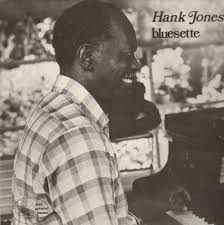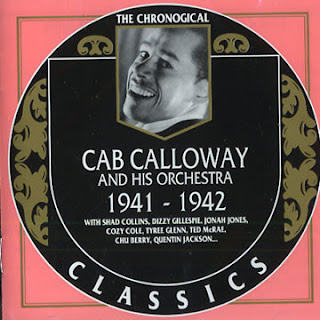Hank Jones - Bluesette
Before Wynton Marsalis and the Young Lions movement made straight ahead jazz mainstream in the 1980's, the music was mostly in the underground. Dexter Gordon's 1976 signing with Columbia in 1976 was one of the first steps towards popularizing straight ahead jazz again, but for the most part, many of jazz's biggest names were recording for smaller labels like Pablo, Mainstream, Muse, and others. Black & Blue was one such label and they produced some of the finest recordings. Based in France, their jazz focus centered on swing their roster includes Milt Buckner, Earl Hines, Major Holley, Arnett Cobb, Illinois Jacquet, Sir Charles Thompson, and Hank Jones.
Bluesette is his third and final album for the label and though it features the same trio lineup with George Duvivier (1920-1985) on bass and Alan Dawson (1929-1992) on drums, in my opinion it is far superior to the previous album (I covered it here). The main reason is the improved sound quality, the album was recorded in London and the drums come out clearly. This is so important because, like the last album Dawson plays brushes on all tracks except one, and the art of brushwork is all about 'painting' with the drums. If you can't hear it properly then it's lost. But here, the bass drum rings clearly and the swish of the brush is right there. It's a nuanced and subtle art and Alan Dawson is one of the masters. He is also much more interactive with the soloists on this record and his accompanying is incredible. He never seems to run out of ideas and is a adept at the drummer's supportive role. He also shines during his trading and his multiple solo spots. His solo style seems rudiments-based. Not as flashy as Philly Joe Jones and perhaps more subtle (the brushes help) and more defined.
George Duvivier is a very similar player to Jones in that his vocabulary is based on bop principles. He improvises like a horn player with long lines that encompass a wide range on his instrument. His walking style is also smooth and I think it is because of his amplification. Pre-bop bassists tended to have a heavy quarter note sound due not only to the nature of the music and feel, but also because they tended to play with higher action. Amplification allowed for bassists to play with lowered action and most jazz bassists in the 1970s went this direction. Duvivier's sound is not quite as smooth or liquid-y as Eddie Gomez, but I believe the amplification modernized his feel and just because of the sound, but the fact it let his notes ring out more than before.
Hank Jones must have been thrilled to record in this setting. Acoustic-based jazz was not quite in yet in 1979, but was slowly making a comeback. It's not so much that fusion had run its course, but every fusion band bases their sound on current instruments and technology---sounds destined to become dated as the technology is being constantly improved or updated. As a result, the music and the musicians are at a stronger odds to go out of fashion. Besides, it was merging with rhythm and blues (à la David Sanborn, Grover Washington, et al.) to update the fusion sound in the 1980s. Acoustic based jazz is very much about the acoustic sounds but it's also very much about the notes, the harmony, the rhythms, and the entire performance practice that makes it the art form. The music will always sound timeless.
Jones might be the most modern player of their roster, but no doubt his conception is based in swing as evidenced by his soft, light sound and sweet touch that seems to stem all the way back to Teddy Wilson. Born in 1918, he was already in mid-twenties by the time the bop revolution but he soaked up and it dominated his improvisational vocabulary. I talk about this in the other article, but he seems to really be the ideal "Swing to Bop" jazz musician. But he is a musical sponge able to work in all kinds of settings from piano trio to backing a singer to playing in a big band to working as a studio musician. As a result, his vocabulary is vast and by the time he began leading his own groups in the 1970s, he proved to be a unique voice and to be one of the living legend---a status he maintained through his death in 2010.
 |
| 1986 French reissue |
 |
| 1993 Japan reissue |
The program centers around original compositions by jazz musicians, mostly from the swing era: Count Basie's "Blue and Sentimental", Benny Carter's "Blues in my Heart", and two by Duke Ellington "Things Ain't What They Used To Be" and the lesser-played "Azure". These are rounded with "Down", a lesser known tune by Miles Davis, Toots Thielmans' waltz entitled "Bluesette", and Cal Tjader's "Milt's Mood".
None of the tunes are throwaway jam sessions, but instead comprise of thought out arrangements by Jones. He is the main soloist, but Duvivier solos on every tune and Dawson is given several solo drum spots.
"Bluesette" is taken at a brisk pace and on the waltz form, Jones is rhythmically fluent. "Down" is a bebop blues tune and really showcases Dawson's wide vocabulary on the brushes especially during his two chorus solo.
While "Down" is bebop, Ellington's "Things Ain't What They Used To Be" is loudly played like a down-home, barrelhouse number. Dawson is on sticks and there is a harder swing feel. Jones perhaps sounds less elegant than he normally does, but he still shines. The languid and slow ballad "Azure" is a sixteen-bar AABA form, but becomes a blues for the solos. Jones has a tendency to double up his lines on every tune and he does so here and the band eventually switches time feels. Dawson manages to keep both feels happening behind Duvivier's solo.
"Blues in my Heart" is not a blues, but sounds like one for the first five bars of the A section. Another ballad, Jones alludes to a few blues piano tricks including trills and going up from the third of the chord to the root. Duvivier's solo is excellent highlighting his sweet upper register and his warm-sounding low register.
Basie's "Blue and Sentimental" and "St. James Infirmary" by Joe Primrose are played solo. Jones' touch is light and understated, so much so that it sounds like he's using the sostenuto pedal! He can be easily mistaken for a lounge piano player, but if one takes the time to listen to his notes, there is deep artistry. He does play stride but doesn't feel compelled to maintain that texture, freely letting his chords ring or playing bass notes. It ends up sounding like modernized stride piano.
 |
| 1998 French reissue |
Unfortunately, neither this release nor Compassion were ever released in the U.S. The other Black and Blue album, the first one entitled I Remember You, was issued under Classic Jazz in 1978 but otherwise has not been released either. This is excellent piano trio.






Comments
Post a Comment